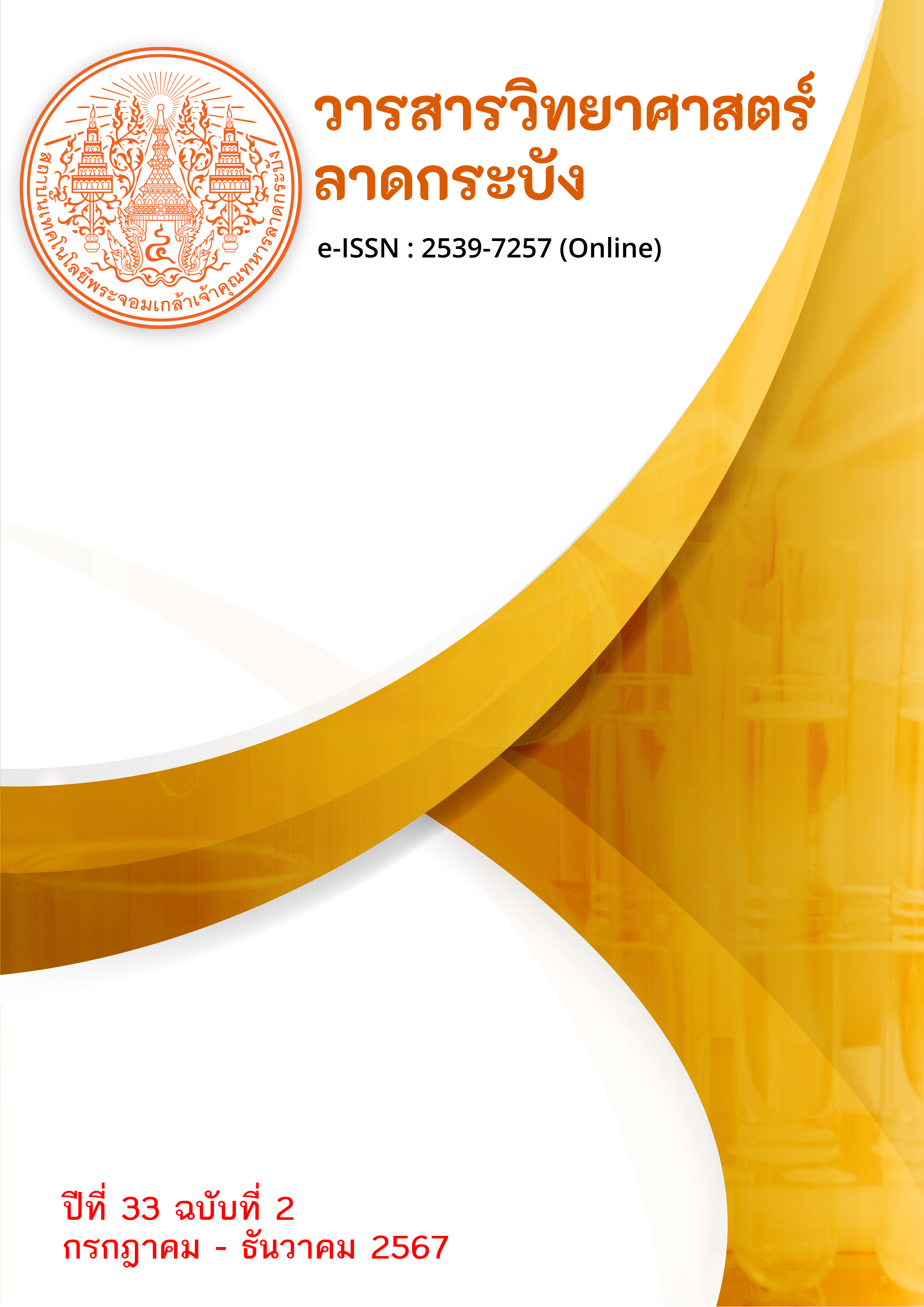การศึกษาเปรียบเทียบวิธีการเมตาฮิวริสติก สำหรับปัญหาที่มีเงื่อนไข ข้อจำกัดทางทรัพยากร
Main Article Content
บทคัดย่อ
วิธีการหาค่าเหมาะสมที่สุดและวิธีเมตาฮิวริสติก นับเป็นวิธีการที่มีประสิทธิผลในการแก้ปัญหาทางวิศวกรรมที่ไม่มีข้อจำกัดและมีข้อจำกัดทางทรัพยากร วิธีเมตาฮิวริสติกเป็นกระบวนการค้นหาแบบวนซ้ำ ซึ่งดำเนินการสำรวจและใช้ประโยชน์จากคำตอบที่เป็นไปได้ทั้งหมดอย่างมีประสิทธิภาพ โดยวิธีเมตาฮิวริสติกจะค้นหาคำตอบที่ใกล้เคียงกับคำตอบที่ดีที่สุดอย่างมีประสิทธิภาพและประสิทธิผล งานวิจัยนี้มีวัตถุประสงค์เพื่อประเมินและทดสอบประสิทธิภาพของวิธีเมตาฮิวริสติก 3 วิธีการ ได้แก่ วิธีผสมเกสรของดอกไม้ วิธีการเคลื่อนที่ของลิฟท์ และวิธีไรเดอร์ ในการแก้ปัญหาที่มีเงื่อนไขและไม่มีเงื่อนไขข้อจำกัดทางทรัพยากร การประเมินประสิทธิภาพของวิธีการต่าง ๆ ประกอบด้วย ค่าเฉลี่ย ค่าเบี่ยงเบนมาตรฐาน เวลาในการประมวลผล และค่าอัตราส่วนเอสต่อเอ็น ผลจากการทดลองพบว่า วิธีไรเดอร์มีความสามารถที่ดีกว่าวิธีการเมตาฮิวริสติกทั้งสองวิธีอย่างชัดเจน ในด้านของความแม่นยำและคุณภาพของผลลัพธ์ รวมไปถึงการใช้จำนวนการค้นหาคำตอบที่น้อยกว่าในการนำไปสู่การผลลัพธ์ที่ดีที่สุด ในงานวิจัยฉบับนี้ วิธีไรเดอร์สามารถหาคำตอบที่ดีที่สุดได้ดีกว่าแต่ให้ค่าส่วนเบี่ยงเบนมาตรฐานที่สูงกว่า นอกจากนั้นวิธีไรเดอร์ยังเป็นวิธีที่ง่ายต่อการนำไปประยุกต์ใช้และไม่ต้องการการปรับค่าพารามิเตอร์ของวิธีการ เมื่อเปรียบเทียบกับวิธีผสมเกสรของดอกไม้และวิธีการเคลื่อนที่ของลิฟท์ที่ต้องมีการปรับค่าพารามิเตอร์ให้เหมาะสม
Article Details

อนุญาตภายใต้เงื่อนไข Creative Commons Attribution-NonCommercial-NoDerivatives 4.0 International License.
เอกสารอ้างอิง
Hao, J.K. and Solnon, C. 2020. Metaheuristics and artificial intelligence. In A Guided Tour of Artificial Intelligence Research. Springer, Berlin, 27–52.
Kaveh, M. and Mesgari, M.S. 2023. Application of metaheuristic algorithms for training neural networks and deep learning architectures: a comprehensive review. Neural Processing Letters, 55, 4519–4622, https://doi.org/10.1007/s11063-022-11055-6.
Pavai, G. and Geetha, T.V. 2019. New crossover operators using dominance and co-dominance principles for faster convergence of genetic algorithms. Soft Computing, 23, 3661–3686, https://doi.org/10.1007/s00500-018-3016-1.
Storn, R. and Price, K. 1997. Differential evolution - a simple and efficient heuristic for global optimization over continuous spaces. Journal of Global Optimization, 11(4), 341–359.
Kennedy, J. and Eberhart, R. 1995. Particle Swarm Optimization. Proceedings of IEEE International Conference on Neural Networks, 4, 1942–1948.
Dorigo, M., Maniezzo, V. and Colorni, A. 1996. Ant system: optimisation by a colony of cooperating agents. IEEE Transactions on Systems, Man, and Cybernetics Part B, 26, 29-41, http://doi.org/10.1109/3477.484436.
Hansen, P., Mladenović, N. and Moreno Pérez, J.A. 2008. Variable neighbourhood search. Metaheuristic procedures for training neutral networks methods and applications, 319-360, https://doi.org/10.1007/s10288-008-0089-1.
Yang, X.S. 2012. Flower pollination algorithm for global optimization. lecture notes in computer science, 7445, 240-249.
Luangpaiboon, P., Aungkulanon, P., Ruekkasaem, L. and Montemanni, R. 2022. An elevator kinematics optimization algorithm based on a large neighborhood search for optimizing simulated industrial problems. Proceedings of the 2022 9th International Conference on Industrial Engineering and Applications (Europe) (ICIEA-2022-Europe). Association for Computing Machinery, New York, NY, USA, 92–97.
Binu, D. and Kariyappa, B.S. 2019. RideNN: A new rider optimization algorithm-based neural network for fault diagnosis in analog circuits. IEEE Transactions on Instrumentation and Measurement, 68(1), 2–26, https://doi.org/10.1109/TIM.2018.2836058.
Glover, F. and Kochenberger, G.A. 2003. Handbook of metaheuristics. Springer New York, New York.
Bandyopadhyay, D. 2008. A simulated annealing-based multi objective optimization algorithm: AMOSA. IEEE Transactions on Evolutionary Computation, 12(3), 269-283, https://doi.org/10.1109/TEVC.2007.900837.
Cvijovic, D. and Klinowski, J. 1995. Taboo search: an approach to the multiple minima problem. Science, 267, 664-666, https://doi.org/10.1126/science.267.5198.664.
Yang, X.S. 2014. Nature Inspired Optimisation Algorithm. Elsevier Inc., London.
Kumpanya, D. 2018. Parameter identification of DC motor model by flower pollination algorithm. RMUTSB ACADEMIC JOURNAL, 6(2), 207-219.
Aungkulanon, P., Luangpaiboon, P. and Montemanni, R. 2018. An elevator kinematics optimisation method for aggregate production planning based on fuzzy MOLP model. International Journal of Mechanical Engineering and Robotics Research, 7(4), 422-427, https://doi.org/10.18178/ijmerr.7.4.422-427.
Luangpaiboon, P. and Juttijudata, S. 2023. Adaptive elevator kinematics optimization based dual response algorithm for determining proper levels in plaster milling process parameters. Scientific Reports, 13, 8855, https://doi.org/10.1038/s41598-023-35119-2.
Wang, G., Yuan, Y. and Guo, W. 2019. An improved rider optimization algorithm for solving engineering optimization problems. IEEE Access, 7, 80570–80576, https://doi.org/10.1109/ACCESS.2019.2923468.
Kumar, R., Rohitash, K. and Banyal. 2021. Rider Optimization Algorithm (ROA): An optimization solution for engineering problem. Turkish Journal of Computer and Mathematics Education (TURCOMAT), 12(12), 3197-3201, https://doi.org/10.17762/turcomat.v12i12.7994.
Chai-Ead, N., Aungkulanon, P. and Luangpaiboon, P. 2012. Nature-Inspired Algorithms of Bees, Firefly and Bat for Noisy Non-Linear Optimisation Problems. IAENG Transactions on Engineering Technologies, 7, 62-77.
Pansare, V.B. and Kavade, M.V. 2012. Optimization of cutting parameters in multipass turning operation using ant colony algorithm. International Journal of Engineering Science & Advanced Technology, 2(4), 955-960, https://doi.org/10.1142/9789814390019_0005.
Shivakoti, I., Diyaley, S., Kibria, G. and Pradhan, B.B. 2012. Analysis of Material Removal Rate using Genetic Algorithm Approach. International Journal of Scientific & Engineering Research, 3(5), 1-6.
Khan, Z., Prasad, L.B. and Singhl, T. 1997. Machine Condition Optimisation by Genetic Algorithms and Simulated. Computers & Operations Research, 24(7), 647-657, https://doi.org/10.1016/S0305-0548(96)00077-9.
Mahdavi, M., Fesanghary, M. and Damangir, E. 2007. An improved harmony search algorithm for solving optimization problems. Applied Mathematics and Computation. 188(2), 1567-1579, https://doi.org/10.1016/j.amc.2006.11.033.
Ruekkasaem, L. and Aungkulanon, P. 2020. Comparison of forecasting methods for Aggregate Production Planning in Cleanroom Apparel Factory. Phranakhon Rajabhat Research Journal (Science and Technology), 15(1), 86-100.

